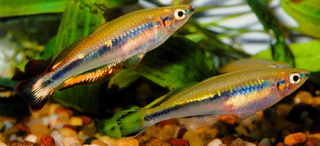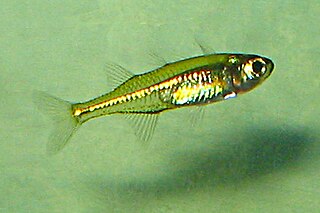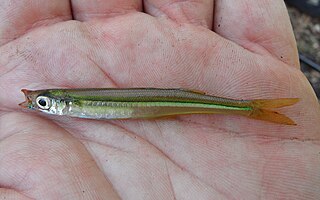
The big-scale sand smelt is a species of fish in the family Atherinidae. It is a euryhaline amphidromous fish, up to 20 cm in length.

The red-tailed silverside, or zona is a species of Madagascar rainbowfish endemic to the Mananjary River drainage in Madagascar. It is threatened by habitat loss and introduced species. It has often been confused with the related B. madagascariensis, which is common in the aquarium trade. In addition to meristics, the two can be separated by the exact colour pattern on their tail fin and the distinct red spot on the lower jaw of breeding male B. geayi. B. geayi was described in 1907 by Jacques Pellegrin from a type collected by the pharmacist and natural history collector Martin François Geay (1859-1910), who Pellegrin honoured with its specific name.

Bedotia madagascariensis (zona) is a species of fish in the family Bedotiidae. It is endemic to Madagascar, where found in rivers and lakes between the Ivoloina River and the Manambolo Creek. It is commonly seen in the aquarium trade, where it often has been confused with the related B. geayi. It is threatened by habitat loss. It was described by Charles Tate Regan in 1903 with Madagascar given as the type locality, Regan deposited the type in the Muséum d'histoire naturelle de Genève and named the genus in honour of its director Maurice Bedot (1859-1927).
Chirostoma bartoni, the Alberca silverside, was a species of neotropical silverside endemic to the Lerma River basin of Mexico. Typical adult specimens were approximately 7.1 cm in length.

Chirostoma humboldtianum, the shortfin silverside, is a species of neotropical silverside endemic to Mexico. It reaches a maximum length of around 20 cm. This species was described as Atherina humboldtiana by Achille Valenciennes in 1835 with a type locality of "Mexico". Valenciennes gave it its specific name in honour of the Prussian explorer Alexander von Humboldt (1769-1859).
Glover's hardyhead is a species of fish in the family Atherinidae endemic to Dalhousie Springs in the Lake Eyre basin, Australia. The fish has a high thermal tolerance and inhabits warm, freshwater spring-fed pools and channels. It is listed as vulnerable on the IUCN Red List. The specific name honours John Glover (1935–1992) who was the Curator of Fishes at the South Australian Museum.
The Drysdale hardyhead is a species of fish in the family Atherinidae endemic to the Drysdale River in the Kimberley region of Australia. It is listed as near threatened on the IUCN Red List and rare under the Australian EPBC Act 1999. The specific name honours Ivantsoff's wife, Helena.
Kailola's hardyhead is a species of fish in the family Atherinidae endemic to Papua New Guinea. It reaches a maximum length of 6 cm. It inhabits shallow, clear creeks with gravel substrate. This species was described by Walter Ivantsoff, Lucy Crowley and Gerald R. Allen in 1987 with a type locality of a still backwater of Foasi Creek 3 kilometers west of Safia airstrip in Papua New Guinea. The specific name honours the Patricia J. Kailola, for her contribution to the knowledge of the ichthyology of Papua New Guinea.
The Magela hardyhead or Mariana's Hardyhead, is a species of fish in the family Atherinidae endemic to Australia. It has a very restricted distribution, only found in the Alligator Rivers region of the Northern Territory where it inhabits shallow and fast-flowing freshwater creeks. The fish has a high thermal tolerance, like some other species in the genus Craterocephalus, and may tolerate water temperatures up to 39.5º. The specific name honours Walter Ivantsoff's daughter, Marian.

Poblana ferdebueni, the Chignahuapan silverside is a species of neotropical silverside endemic to Mexico. This species was described by Aurelio Solórzano Preciado and Irma López-Guerrero in 1965 from a type locality of Laguna de Almoloya, Chignahuapan Lake, Puebla State, Mexico and was fiven the specific name derdebueni to honour the Spanish ichthyologist Fernando de Buen y Lozano (1895-1962) who had originally proposed the genus Poblana.
Teramulus kieneri, the Keiner's silverside or vily, is a species of silverside endemic to Madagascar where it is found in rivers around on the eastern coast. This species was described by J.L.B. Smith in 1965 with the type locality given as the coastal swamps near Tamatave. It has since been found in other areas of the island, including the basin pf the Nosivolo River and in the Bemarivo River. Smith gave this species the specific name keineri to honour the French fisheries scientist, André Kiener, who assisted in the collection of the type in 1961, although it was initially reported as Atherinomorus duodecimalis. It is the type species of the genus Teramulus.
Teramulus waterloti is a species of silverside from the [[subfamily Atherinomorinae which is endemic to Madagascar. This species occurs in rivers, creeks, and streams in north western Madagascar from the Mananjeba River south to the Anjingo River. The IUCN classify this species as Endangered and it is threatened by deforestation which degrades its habitat through sedimentation and by the introduction of invasive fish species such as Channa maculata. This fish was described in 1932 as the subspecies waterloti of Atherina duodecimalis by Jacques Pellegrin who named it after Georges Waterlot (1877-1939), a collector of specimens in Africa and Madagascar for Muséum national d'histoire naturelle, including the type of this species, which he collected from Antikotazo Creek, District d'Ambilobé, Diégo Suarez Province.

Alepidomus evermanni is a freshwater species of silverside endemic to western Cuba. This species grows to 3.3 cm (1.3 in) in standard length. It is the only known member of its genus. This species was described as Atherina evermanni by Carl H. Eigenmann in 1903 with a type locality of San Cristobal, Cuba. The specific name honours the American ichthyologist Barton Warren Evermann (1853-1932).
Bleheratherina pierucciae is a species of freshwater silverside endemic to New Caledonia. This species grows to 4.7 cm (1.9 in) in standard length. It is the only known species in its genus and subfamily. This species was described by Aarn Aarn and Walter Ivantsoff in 2009 with the type locality of the Tontouta River, New Caledonia,. The type was collected by Heiko Bleher and Paola Pierucci and Aarn and Ivantsoff named this species after both of them, the suffix -ae indicating Ms Pierucci's gender.
Membras martinica, the rough silverside, is a species of Neotropical silverside from the family Atherinopsidae, it is the type species of the genus Membras.

Craterocephalus marjoriae, commonly known as Marjorie's hardyhead or silverstreak hardyhead, is a species of fish in the family Atherinidae that is native to eastern Australia, namely central Queensland to northeastern New South Wales. Here it inhabits clear flowing streams and it is common among the vegetation in their margins. It prefers shallow water over streambeds consisting of sand or gravel. It forms shoals. They spawn on multiple occasions between September and January, although this peaks earlier in the season. They form pairs for spawning, the eggs being deposited on aquatic vegetation to which they adhere. The eggs are large measuring 1.15-1.25 mm in diameter and have adhesive filaments. The eggs hatch after around a week and the larvae measure about 5.7 mm standard length. Their diet consist mostly of aquatic insects and their larvae, small crustaceans, algae and fish eggs. This species was described by Gilbert P. Whitley in 1948 with the type locality given as Eidsvold on the Burnett River in Queensland. Whitley may have named this species in honour of his sister Marjorie Frewer.
The panatela silverside is a species of reef-dwelling silverside from the subfamily Atherinomorinae which is found in the southwest Pacific Ocean. This species grows to 11 cm (4.3 in) in total length and is of minor importance to commercial fisheries. This species is the only species in the genus Stenatherina, although some authorities place it in the genus Hypoatherina. This species was described by David Starr Jordan and Robert Earl Richardson as Atherina panatela with the type locality given as Calayan Island in the Philippines. The specific name is the Spanish word for a long, thin cigar and is presumed to be a reference to the elongated, slender body of this fish.

Labidesthes vanhyningi, the golden silverside, is a species of Neotropical silverside from North America. This is a pelagic and neritic freshwater fish which is found in river systems draining into the Gulf of Mexico from the Neches River to southern Florida. It was described by Barton A. Bean and Earl D. Reid in 1930 from a type locality of Prairie Creek, 6 miles east of Gainesville, Florida and named in honour of the collector of the type, herpetologist Oather C. Van Hyning, the son of Thompson H. Van Hyning who was the first director of the Florida Museum of Natural History.
Atherion elymus, the bearded silverside or pickleface hardyhead, is a species of silverside from the family Atherionidae. It is found in the western Pacific Ocean.
McCulloch's hardyhead is a species of silverside from the family Atherionidae. This species occurs off the coasts of Australia. It was described by David Starr Jordan and Carl Leavitt Hubbs in 1919 from a type locality of Lord Howe Island and the specific name honours the Australian ichthyologist Allan Riverstone McCulloch (1885-1925), who was Curator of Fishes at the Australian Museum and who provided Jordan and Hubbs with the type.







